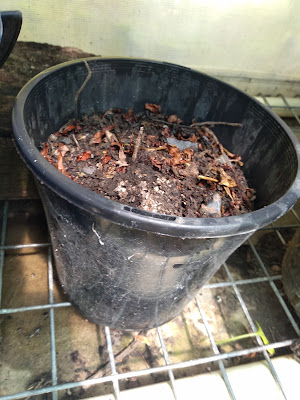I grow a lot of edible things. I like to grow things that I otherwise could not eat, such as mulberries or diploid potatoes or pink/purple sweet corn.
I also grow a few ornamental plants including a few nice ferns. Like many people, I also have a few succulents.
Variegated succulents
Recently I got a cutting from a variegated succulent, I need to look up what it is but have been told it is a 'tree houseleek'. It has changed a bit since I planted it, but I still like its colours.
This cutting has a few offshoots. If it grows well, after some time I should be able to remove the offshoots and grow a few more of them.
 |
| Variegated succulent |
 |
| Offsets under the main rosette |
 |
| Should be simple to divide once it grows |
I also got some cuttings of a different variegated succulent which has similar colours. I like these variegated succulents more than the first one, they look nice. Someone told me the one below is Crassula ovata ‘Tricolor’.
If it grows I should be able to divide it into several plants.
 |
| Variegated succulent |
 |
| There are a few in this pot |
String of buttons
A few years ago my daughter bought a string of buttons succulent (Crassula perforata). I don't know what she liked more, the plant or its name.
It was such a tiny plant when she bought it, and it has grown well. She grew it for a long time, and it started to divide, and then flower.
I helped her divide it, and she now has three of them (I only took photos of two).
 |
| String of buttons succulent |
 |
| String of buttons |
String of pearls
I like string of pearls succulents (Senecio rowleyanus). They aren't as hardy as many succulents, but they are simple to grow and they look incredible. Mine flower each winter, the flowers are not overly interesting to look at, but they smell like cinnamon.
The ones below are almost a meter long, and will get even longer if I can protect them.
At this stage I only have plenty of the typical gtreen form, and a small number of variegated string of peals plants. The variegated ones are so pretty, and they grow a lot slower. I also have one cutting of the far larger and rarer 'big peas' or 'perla grande' variety which I can't wait until it grows and shows me what it can really do.
 |
| String of pearls |
 |
| String of pearls succulent |
 |
| String of pearls succulents get rather long |
String of pearls succulents are simple to grow, they will grow in soil or even in water. When pieces break off they can be planted to create new plants. Below are some of the cuttings I am growing out.
It takes some time and a bit of space to grow them long. For this reason small plants are relatively inexpensive, and longer plants tend to cost a lot more.
 |
| String of pearls cuttings |
String of beans, string of fishhooks, string of bananas
Recently I was given cuttings from a strong of beans succulent (Senecio radicans). This is a different species to the string of pearls. It grows in a similar way, but has longer leaves (rather than spherical leaves of string of pearls). I am told this succulent is hardier, and more vigorous than string of pearls.
When I got the cutting, the leaves were long and thin. After planting the cutting, and watering, the leaves have plumped up a lot. The parent plant grew under harsh conditions for a number of years, so my cutting became plump and has grown fast since I planted the cutting and gave it water.
Over winter these can take on a purplish tinge to the leaves. The flowers are large and smell like cinnamon.
 |
| String of beans succulent |
String of dolphins
I got a cutting from a string of dolphins (Senecio × peregrinus) a while ago. String of dolphins is an interspecific hybrid of Senecio rowleyanus (String of Pearls) and Senecio articulatus.
On the right angle, when not watered very well, the leaves look like dolphins. When over watered the leaves plump up and no longer look much like dolphins.
I have had it for over a year and it is still so tiny. It is in a pot with other plants, but by now I had expected it to be much larger. This plant is growing so slowly that I think it is not loving life and needs to be moved to a different position or a different pot or something.
 |
| String of dolphins |
Shrek's ear
My son saw a succulent called Shrek's ear that he was rather impressed by. He took one leaf from this plant and asked me to grow this for him as a cutting. I believe it to be Crassula but am not sure of the species.
From that one leaf, my son grew it into this healthy plant. I also have a few zygocactus cuttings in the pot with it. The zygocactus looks poorly, but it flowers.
I need to repot this one for my son, and put the zygocactus in its own pot. After the Shrek's ear settles in we should divide it into two large plants.
 |
| Shrek's ear succulent |
 |
| Succulent and zygocactus |
There are also a few succulents growing in the garden. Among them are a few Aloe vera plants. I don't pay them a great deal of attention.
I do sell string of pearls plants and cuttings through my for sale page. At some stage I will probably list some of the other succulents for sale.






















































